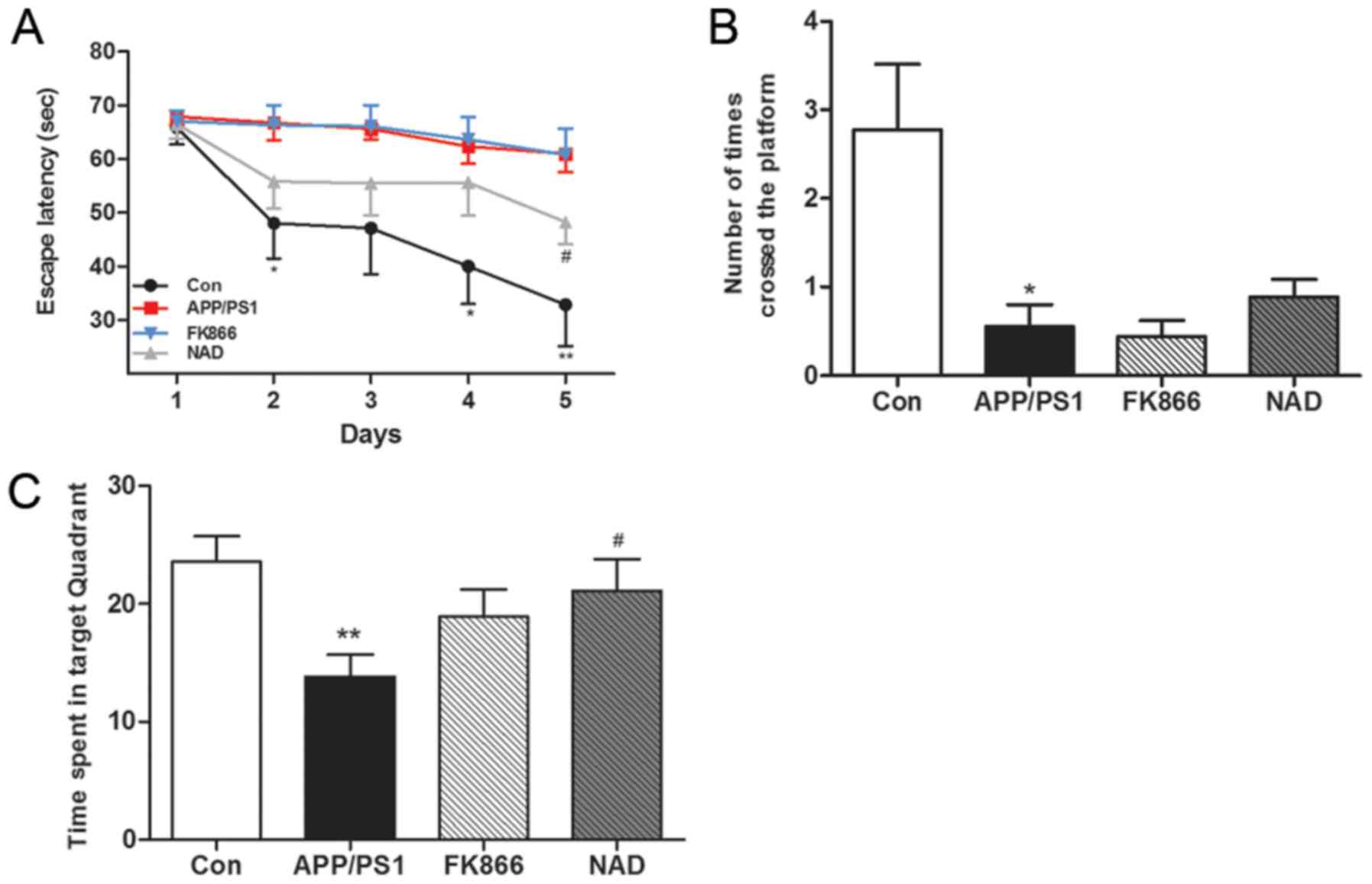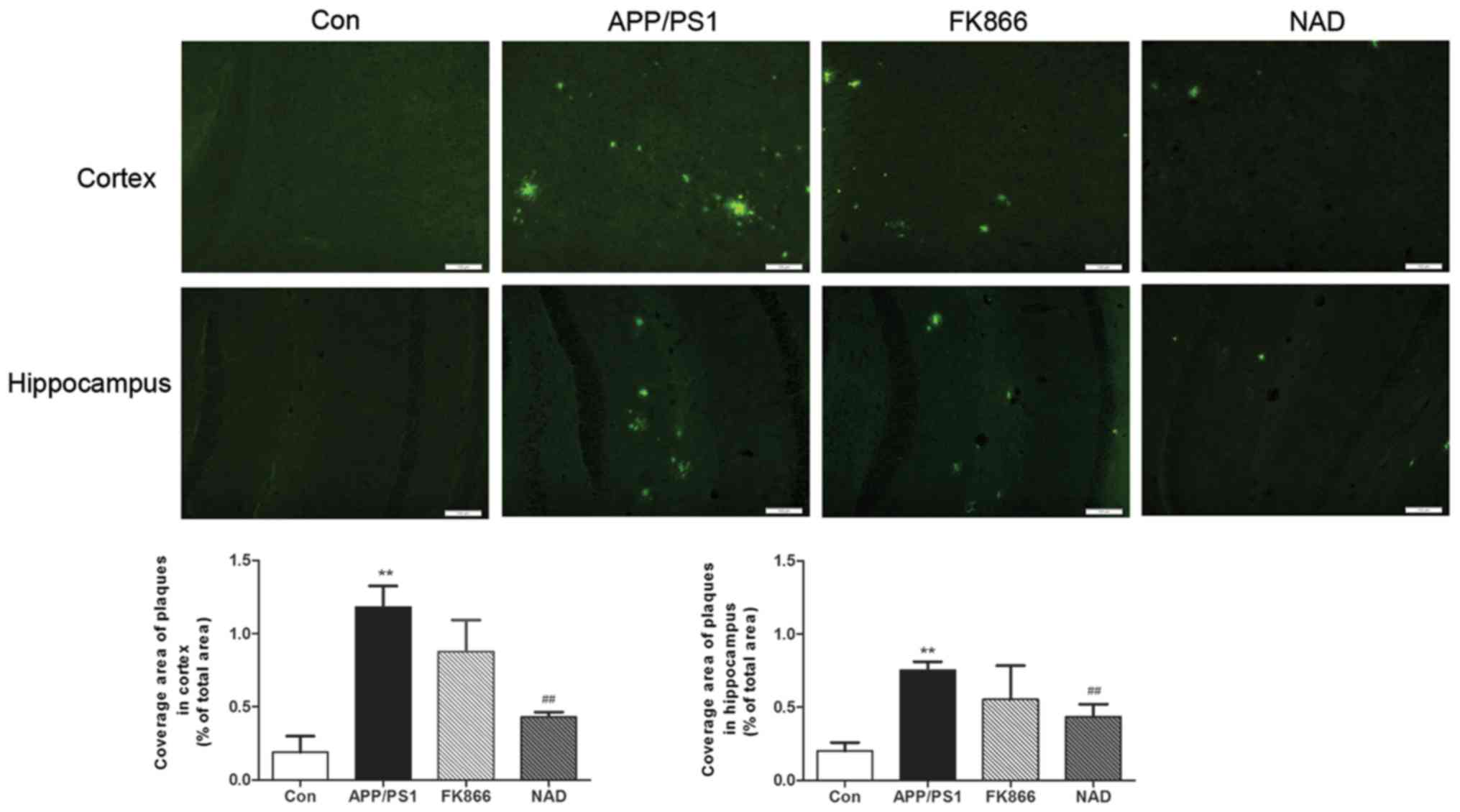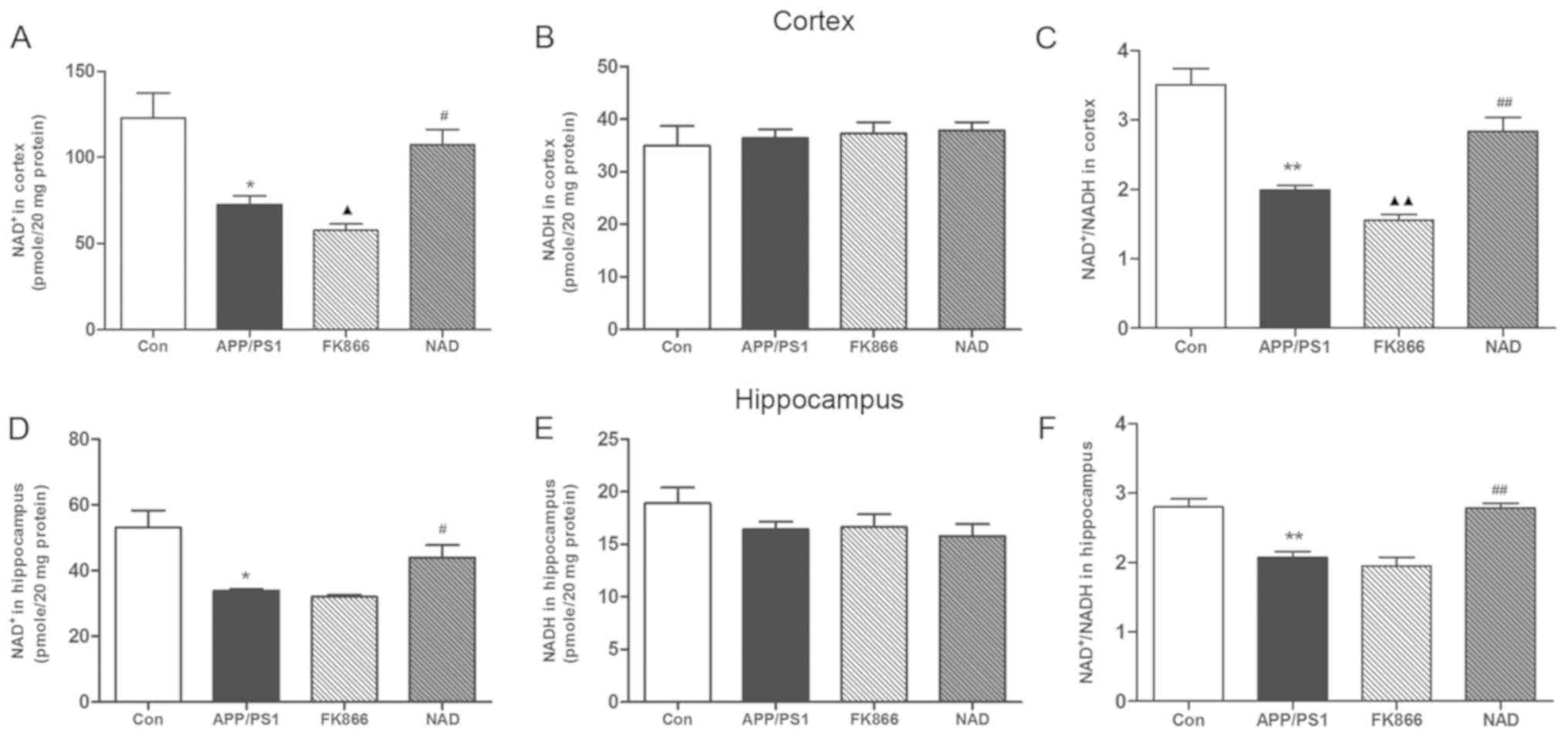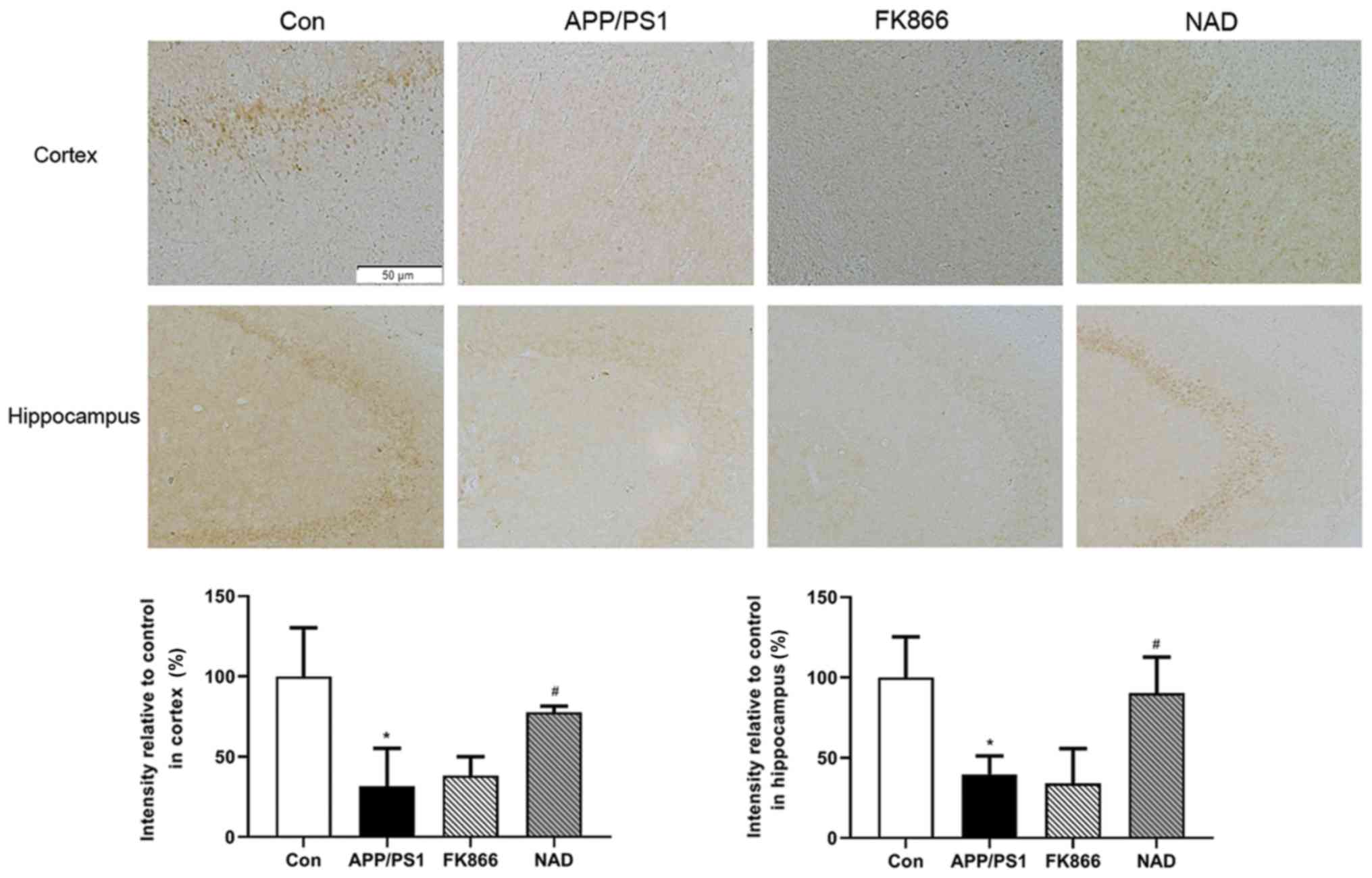|
1
|
Hardy J and Selkoe DJ: The amyloid
hypothesis of Alzheimer's disease: Progress and problems on the
road to therapeutics. Science. 297:353–356. 2002. View Article : Google Scholar : PubMed/NCBI
|
|
2
|
Yin F, Boveris A and Cadenas E:
Mitochondrial energy metabolism and redox signaling in brain aging
and neurodegeneration. Antioxid Redox Signal. 20:353–371. 2014.
View Article : Google Scholar : PubMed/NCBI
|
|
3
|
Yin F, Sancheti H, Patil I and Cadenas E:
Energy metabolism and inflammation in brain aging and Alzheimer's
disease. Free Radic Biol Med. 100:108–122. 2016. View Article : Google Scholar : PubMed/NCBI
|
|
4
|
Cabezas-Opazo FA, Vergara-Pulgar K, Pérez
MJ, Jara C, Osorio-Fuentealba C and Quintanilla RA: Mitochondrial
dysfunction contributes to the pathogenesis of Alzheimer's disease.
Oxid Med Cell Longev. 2015:5096542015. View Article : Google Scholar : PubMed/NCBI
|
|
5
|
Han XJ, Hu YY, Yang ZJ, Jiang LP, Shi SL,
Li YR, Guo MY, Wu HL and Wan YY: Amyloid β-42 induces neuronal
apoptosis by targeting mitochondria. Mol Med Rep. 16:4521–4528.
2017. View Article : Google Scholar : PubMed/NCBI
|
|
6
|
Wang R, Li JJ, Diao S, Kwak YD, Liu L, Zhi
L, Büeler H, Bhat NR, Williams RW, Park EA and Liao FF: Metabolic
stress modulates Alzheimer's β-secretase gene transcription via
SIRT1-PPARү-PGC-1 in neurons. Cell Metab. 17:685–694. 2013.
View Article : Google Scholar : PubMed/NCBI
|
|
7
|
Wu MF, Yin JH, Hwang CS, Tang CM and Yang
DI: NAD attenuates oxidative DNA damages induced by amyloid
beta-peptide in primary rat cortical neurons. Free Radic Res.
48:794–805. 2014. View Article : Google Scholar : PubMed/NCBI
|
|
8
|
Seixas da Silva GS, Melo HM, Lourenco MV,
Lyra E Silva NM, de Carvalho MB, Alves-Leon SV, de Souza JM, Klein
WL, da-Silva WS, Ferreira ST and De Felice FG: Amyloid-β oligomers
transiently inhibit AMP-activated kinase and cause metabolic
defects in hippocampal neurons. J Biol Chem. 292:7395–7406. 2017.
View Article : Google Scholar : PubMed/NCBI
|
|
9
|
Rijpma A, van der Graaf M, Meulenbroek O,
Olde Rikkert MGM and Heerschap A: Altered brain high-energy
phosphate metabolism in mild Alzheimer's disease: A 3-dimensional
31P MR spectroscopic imaging study. Neuroimage Clin.
18:254–261. 2018. View Article : Google Scholar : PubMed/NCBI
|
|
10
|
Rajmohan R and Reddy PH: Amyloid-beta and
phosphorylated tau accumulations cause abnormalities at synapses of
Alzheimer's disease Neurons. J Alzheimers Dis. 57:975–999. 2017.
View Article : Google Scholar : PubMed/NCBI
|
|
11
|
Elhassan YS, Philp AA and Lavery GG:
Targeting NAD+ in metabolic disease: New insights into an old
molecule. J Endocr Soc. 1:816–835. 2017. View Article : Google Scholar : PubMed/NCBI
|
|
12
|
Rongvaux A, Shea RJ, Mulks MH, Gigot D,
Urbain J, Leo O and Andris F: Pre-B-cell colony-enhancing factor,
whose expression is up-regulated in activated lymphocytes, is a
nicotinamide phosphoribosyltransferase, a cytosolic enzyme involved
in NAD biosynthesis. Eur J Immunol. 32:3225–3234. 2002. View Article : Google Scholar : PubMed/NCBI
|
|
13
|
Garten A, Schuster S, Penke M, Gorski T,
de Giorgis T and Kiess W: Physiological and pathophysiological
roles of NAMPT and NAD metabolism. Nat Rev Endocrinol. 11:535–546.
2015. View Article : Google Scholar : PubMed/NCBI
|
|
14
|
Ruggieri S, Orsomando G, Sorci L and
Raffaelli N: Regulation of NAD biosynthetic enzymes modulates
NAD-sensing processes to shape mammalian cell physiology under
varying biological cues. Biochim Biophys Acta. 1854:1138–1149.
2015. View Article : Google Scholar : PubMed/NCBI
|
|
15
|
Verdin E: NAD+ in aging,
metabolism, and neurodegeneration. Science. 350:1208–1213. 2015.
View Article : Google Scholar : PubMed/NCBI
|
|
16
|
Zhang Y, Zhang Y, Li X, Zhang M and Lv K:
Microarray analysis of circular RNA expression patterns in
polarized macrophages. Int J Mol Med. 39:373–379. 2017. View Article : Google Scholar : PubMed/NCBI
|
|
17
|
Trinchese F, Liu S, Battaglia F, Walter S,
Mathews PM and Arancio O: Progressive age-related development of
alzheimer-like pathology in app/ps1 mice. Ann Neurol. 55:801–814.
2004. View Article : Google Scholar : PubMed/NCBI
|
|
18
|
Janus C, Flores AY, Xu G and Borchelt DR:
Behavioral abnormalities in app swe/ps1de9 mouse model of ad-like
pathology: Comparative analysis across multiple behavioral domains.
Neurobiol Aging. 36:2519–2532. 2015. View Article : Google Scholar : PubMed/NCBI
|
|
19
|
Balducci C, Mancini S, Minniti S, La
Vitola P, Zotti M, Sancini G, Mauri M, Cagnotto A, Colombo L,
Fiordaliso F, et al: Multifunctional liposomes reduce brain
β-amyloid burden and ameliorate memory impairment in Alzheimer's
disease mouse models. J Neurosci. 34:14022–14031. 2014. View Article : Google Scholar : PubMed/NCBI
|
|
20
|
Caccamo A, Branca C, Talboom JS, Shaw DM,
Turner D, Ma L, Messina A, Huang Z, Wu J and Oddo S: Reducing
ribosomal protein S6 Kinase 1 expression improves spatial memory
and synaptic plasticity in a mouse model of Alzheimer's disease. J
Neurosci. 35:14042–14056. 2015. View Article : Google Scholar : PubMed/NCBI
|
|
21
|
Kim SY, Cohen BM, Chen X, Lukas SE, Shinn
AK, Yuksel AC, Li T, Du F and Öngür D: Redox Dysregulation in
schizophrenia revealed by in vivo NAD+/NADHH measurement. Schizophr
Bull. 43:197–204. 2017. View Article : Google Scholar : PubMed/NCBI
|
|
22
|
Blass JP, Sheu RK and Gibson GE: Inherent
abnormalities in energy metabolism in Alzheimer disease.
Interaction with cerebrovascular compromise. Ann N Y Acad Sci.
903:204–221. 2000. View Article : Google Scholar : PubMed/NCBI
|
|
23
|
Lewczuk P, Riederer P, O'Bryant SE,
Verbeek MM, Dubois B, Visser PJ, Jellinger KA, Engelborghs S,
Ramirez A, Parnetti L, et al: Cerebrospinal fluid and blood
biomarkers for neurodegenerative dementias: An update of the
consensus of the task force on biological markers in psychiatry of
the world federation of societies of biological psychiatry. World J
Biol Psychiatry. 19:244–328. 2018. View Article : Google Scholar : PubMed/NCBI
|
|
24
|
Pérez MJ, Ponce DP, Aranguiz A, Behrens MI
and Quintanilla RA: Mitochondrial permeability transition pore
contributes to mitochondrial dysfunction in fibroblasts of patients
with sporadic Alzheimer's disease. Redox Biol. 19:290–300. 2018.
View Article : Google Scholar : PubMed/NCBI
|
|
25
|
Swerdlow RH, Koppel S, Weidling I, Hayley
C, Ji Y and Wilkins HM: Mitochondria, Cybrids, Aging, and
Alzheimer's disease. Prog Mol Biol Transl Sci. 146:259–302. 2017.
View Article : Google Scholar : PubMed/NCBI
|
|
26
|
Adiele RC and Adiele CA: Mitochondrial
regulatory pathways in the pathogenesis of Alzheimer's disease. J
Alzheimers Dis. 53:1257–1270. 2016. View Article : Google Scholar : PubMed/NCBI
|
|
27
|
Velliquette RA, O'Connor T and Vassar R:
Energy inhibition elevates beta-secretase levels and activity and
is potentially amyloidogenic in APP transgenic mice: Possible early
events in Alzheimer's disease pathogenesis. J Neurosci.
25:10874–10883. 2005. View Article : Google Scholar : PubMed/NCBI
|
|
28
|
Wu Z, Zhu Y, Cao X, Sun S and Zhao B:
Mitochondrial toxic effects of Aβ through mitofusins in the early
pathogenesis of Alzheimer's disease. Mol Neurobiol. 50:986–996.
2014. View Article : Google Scholar : PubMed/NCBI
|
|
29
|
Lauretti E, Li JG, Di Meco A and Pratico
D: Glucose deficit triggers tau pathology and synaptic dysfunction
in a tauopathy mouse model. Transl Psychiatry. 7:e10202017.
View Article : Google Scholar : PubMed/NCBI
|
|
30
|
Fang EF: Mitophagy and NAD+
inhibit Alzheimer disease. Autophagy. 15:1112–1114. 2019.
View Article : Google Scholar : PubMed/NCBI
|
|
31
|
Ghosh D, Levault KR and Brewer GJ:
Relative importance of redox buffers GSH and NAD+(P)H in
age-related neurodegeneration and Alzheimer disease-like mouse
neurons. Aging Cell. 13:631–640. 2014. View Article : Google Scholar : PubMed/NCBI
|
|
32
|
Yang Y and Sauve AA: NAD(+) metabolism:
Bioenergetics, signaling and manipulation for therapy. Biochim
Biophys Acta. 1864:1787–1800. 2016. View Article : Google Scholar : PubMed/NCBI
|
|
33
|
Pehar M, Harlan BA, Killoy KM and Vargas
MR: Nicotinamide adenine dinucleotide metabolism and
Neurodegeneration. Antioxid Redox Signal. 18:1652–1668. 2018.
View Article : Google Scholar
|
|
34
|
Stein LR and Imai S: The dynamic
regulation of NAD metabolism in mitochondria. Trends Endocrinol
Metab. 23:420–428. 2012. View Article : Google Scholar : PubMed/NCBI
|
|
35
|
Long AN, Owens K, Schlappal AE, Kristian
T, Fishman PS and Schuh RA: Effect of nicotinamide mononucleotide
on brain mitochondrial respiratory deficits in an Alzheimer's
disease-relevant murine model. BMC Neurol. 15:192015. View Article : Google Scholar : PubMed/NCBI
|
|
36
|
Yao Z, Yang W, Gao Z and Jia P:
Nicotinamide mononucleotide inhibits JNK activation to reverse
Alzheimer disease. Neurosci Lett. 647:133–140. 2017. View Article : Google Scholar : PubMed/NCBI
|
|
37
|
Wang X, Zhang Q, Bao R, Zhang N, Wang Y,
Polo-Parada L, Tarim A, Alemifar A, Han X, Wilkins HM, et al:
Deletion of NAMPT in projection neurons of adult mice leads to
motor dysfunction, Neurodegeneration, and death. Cell Rep.
20:2184–2200. 2017. View Article : Google Scholar : PubMed/NCBI
|
|
38
|
Katsyuba E and Auwerx J: Modulating
NAD+ metabolism, from bench to bedside. EMBO J.
36:2670–2683. 2017. View Article : Google Scholar : PubMed/NCBI
|
|
39
|
Nikiforov A, Kulikova V and Ziegler M: The
human NAD metabolome: Functions, metabolism and
compartmentalization. Crit Rev Biochem Mol Biol. 50:284–297. 2015.
View Article : Google Scholar : PubMed/NCBI
|
|
40
|
Ryu KW, Nandu T, Kim J, Challa S,
DeBerardinis RJ and Kraus WL: Metabolic regulation of transcription
through compartmentalized NAD+ biosynthesis. Science.
360(pii): eaan57802018. View Article : Google Scholar : PubMed/NCBI
|
|
41
|
Zhu XH, Lu M, Lee BY, Ugurbil K and Chen
W: In vivo NAD assay reveals the intracellular NAD contents and
redox state in healthy human brain and their age dependences. Proc
Natl Acad Sci USA. 112:2876–2881. 2015. View Article : Google Scholar : PubMed/NCBI
|
|
42
|
Revollo JR, Grimm AA and Imai S: The
regulation of nicotinamide adenine dinucleotide biosynthesis by
Nampt/PBEF/visfatin in mammals. Curr Opin Gastroenterol.
23:164–170. 2007. View Article : Google Scholar : PubMed/NCBI
|
|
43
|
Lin JB, Kubota S, Ban N, Yoshida M,
Santeford A, Sene A, Nakamura R, Zapata N, Kubota M, Tsubota K, et
al: NAMPT-Mediated NAD(+) Biosynthesis is essential for vision in
mice. Cell Rep. 17:69–85. 2016. View Article : Google Scholar : PubMed/NCBI
|
|
44
|
Yamamoto T, Byun J, Zhai P, Ikeda Y, Oka S
and Sadoshima J: Nicotinamide mononucleotide, an intermediate of
NAD+ synthesis, protects the heart from ischemia and reperfusion.
PLoS One. 9:e989722014. View Article : Google Scholar : PubMed/NCBI
|
|
45
|
LoCoco PM, Risinger AL, Smith HR, Chavera
TS, Berg KA and Clarke WP: Pharmacological augmentation of
nicotinamide phosphoribosyltransferase (NAMPT) protects against
paclitaxel-induced peripheral neuropathy. Elife. 6:e296262017.
View Article : Google Scholar : PubMed/NCBI
|
|
46
|
Ghosh D, LeVault KR, Barnett AJ and Brewer
GJ: A reversible early oxidized redox state that precedes
macromolecular ROS damage in aging nontransgenic and 3×Tg-AD mouse
neurons. J Neurosci. 32:5821–5832. 2012. View Article : Google Scholar : PubMed/NCBI
|
|
47
|
Sasaki Y, Araki T and Milbrandt J:
Stimulation of nicotinamide adenine dinucleotide biosynthetic
pathways delays axonal degeneration after axotomy. J Neurosci.
26:8484–8491. 2006. View Article : Google Scholar : PubMed/NCBI
|
|
48
|
Chen J, Sysol JR, Singla S, Zhao S,
Yamamura A, Valdez-Jasso D, Abbasi T, Shioura KM, Sahni S, Reddy V,
et al: Nicotinamide Phosphoribosyltransferase promotes pulmonary
vascular remodeling and is a therapeutic target in pulmonary
arterial hypertension. Circulation. 135:1532–1546. 2017. View Article : Google Scholar : PubMed/NCBI
|
|
49
|
Wang SN and Miao CY: Targeting NAMPT as a
therapeutic strategy against stroke. Stroke Vasc Neurol. 4:83–89.
2019. View Article : Google Scholar : PubMed/NCBI
|
|
50
|
Imai S and Yoshino J: The importance of
NAMPT/NAD/SIRT1 in the systemic regulation of metabolism and aging.
Diabetes Obes Metab. 15 (Suppl 3):S26–S33. 2013. View Article : Google Scholar
|
|
51
|
Stein LR and Imai S: Specific ablation of
Nampt in adult neural stem cells recapitulates their functional
defects during aging. EMBO J. 33:1321–1340. 2014.PubMed/NCBI
|
|
52
|
Kiss G, Konrad C, Pour-Ghaz I, Mansour JJ,
Németh B, Starkov AA, Adam-Vizi V and Chinopoulos C: Mitochondrial
diaphorases as NAD+ donors to segments of the cirtric acid cycle
that support substrate-level phosphorylation yielding ATP during
respiratory inhibition. FASEB J. 28:1682–1697. 2014. View Article : Google Scholar : PubMed/NCBI
|
|
53
|
Hou Y, Lautrup S, Cordonnier S, Wang Y,
Croteau DL, Zavala E, Zhang Y, Moritoh K, O'Connell JF, Baptiste
BA, et al: NAD+ supplementation normalizes key Alzheimer's features
and DNA damage responses in a new AD mouse model with introduced
DNA repair deficiency. Proc Natl Acad Sci USA. 115:1876–1885. 2018.
View Article : Google Scholar
|
|
54
|
Wang X, Li H and Ding S: The effects of
NAD+ on apoptotic neuronal death and mitochondrial biogenesis and
function after glutamate Excitotoxicity. Int J Mol. 15:20449–20468.
2014. View Article : Google Scholar
|
|
55
|
Guan Y, Wang SR, Huang XZ, Xie QH, Xu YY,
Shang D and Han CM: Nicotinamide Mononucleotide, an NAD+ Precursor,
Rescues Age-associated susceptibility to AKI in a sirtuin
1-dependent manner. J Am Soc Nephrol. 28:2337–2352. 2017.
View Article : Google Scholar : PubMed/NCBI
|
|
56
|
Du LL, Xie JZ, Cheng XS, Li XH, Kong FL,
Jiang X, Ma ZW, Wang JZ, Chen C and Zhou XW: Activation of sirtuin
1 attenuates cerebral ventricular streptozotocin-induced tau
hyperphosphorylation and cognitive injuries in rat hippocampi. Age
(Dordr). 36:613–623. 2014. View Article : Google Scholar : PubMed/NCBI
|
|
57
|
Bonfili L, Cecarini V, Cuccioloni M,
Angeletti M, Berardi S, Scarpona S, Rossi G and Eleuteri AM: SLAB51
probiotic formulation activates SIRT1 pathway promoting antioxidant
and neuroprotective effects in an AD mouse model. Mol Neurobiol.
55:7987–8000. 2018. View Article : Google Scholar : PubMed/NCBI
|




















